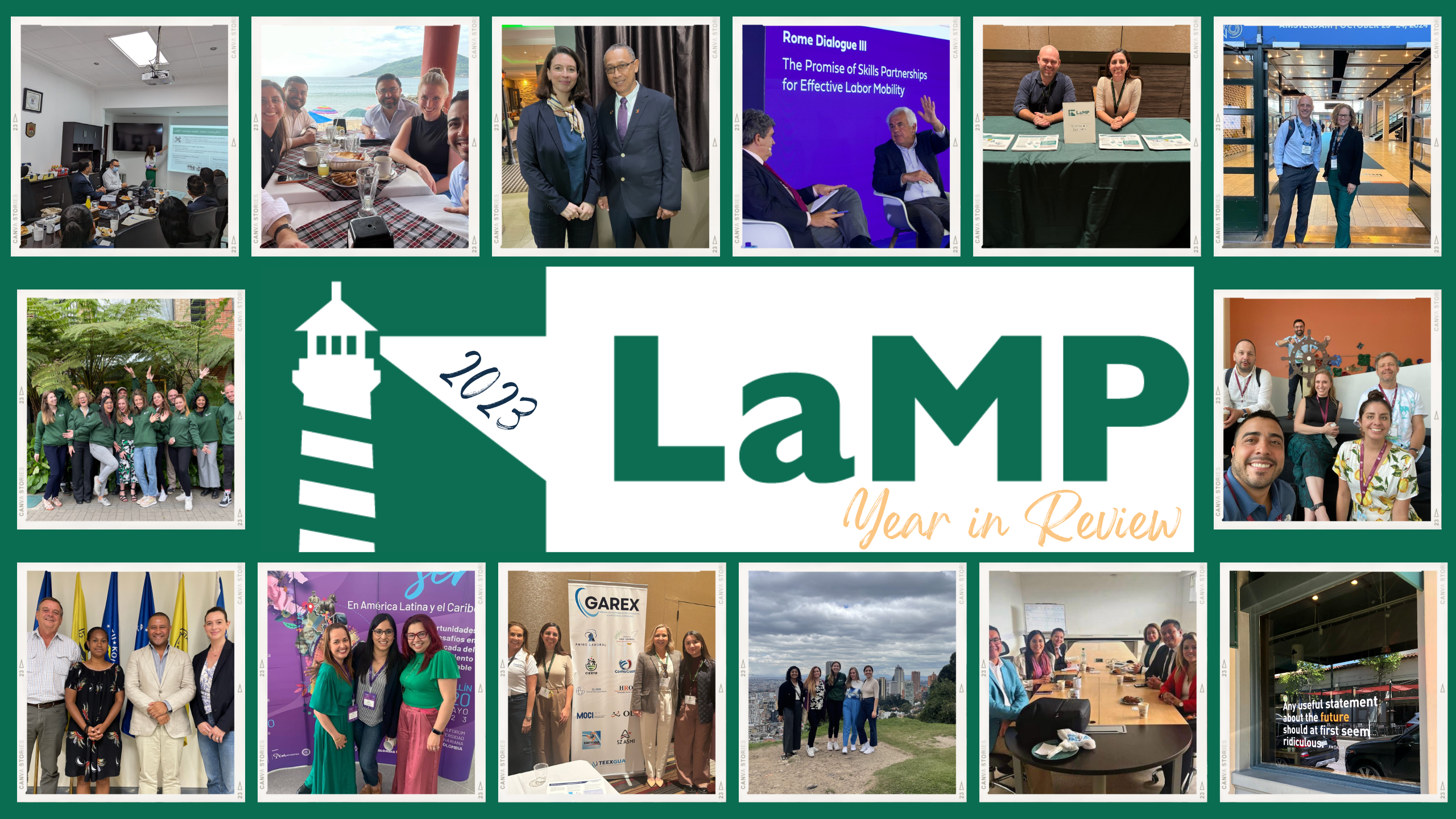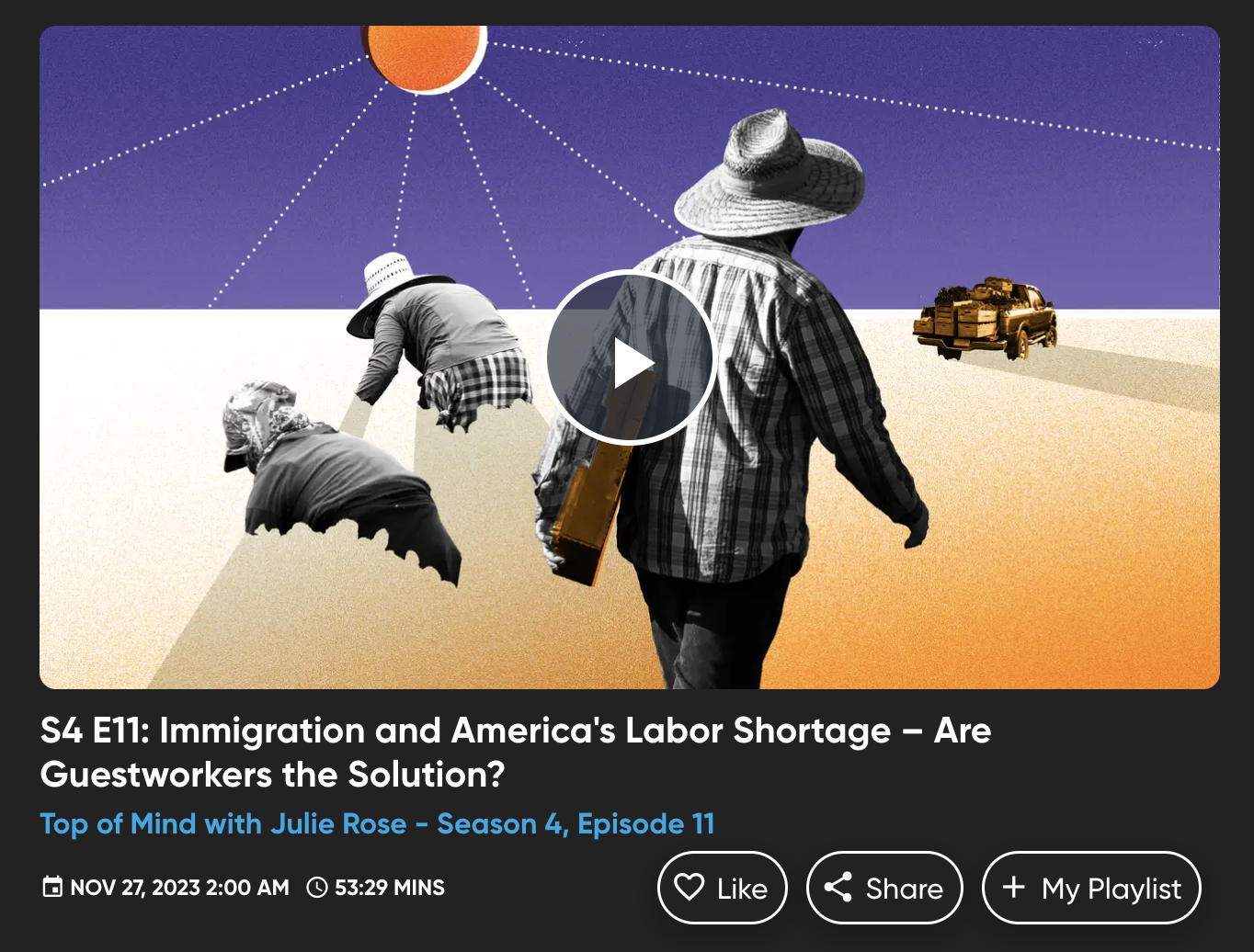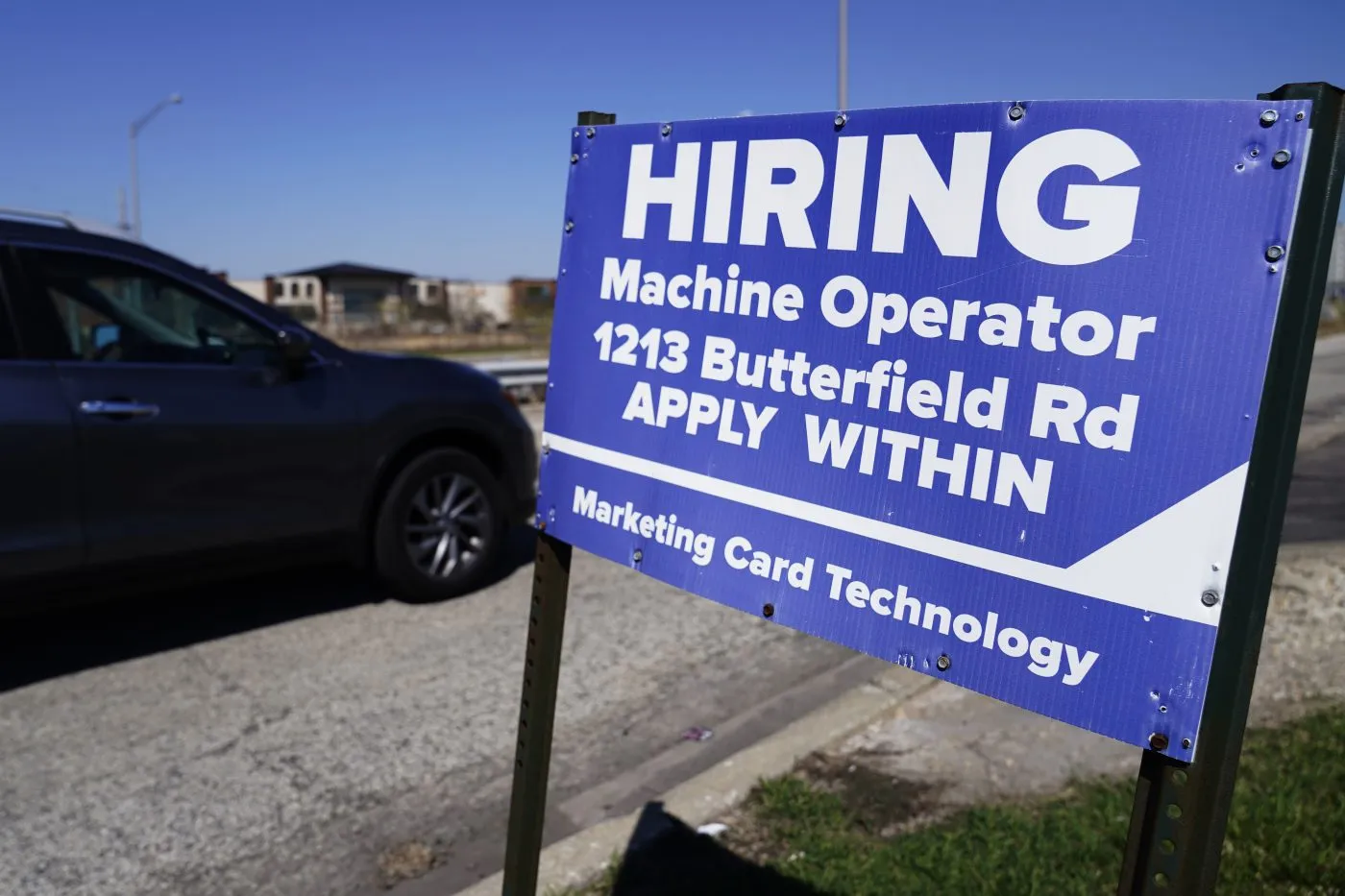
LaMP Year in Review 2023



LaMP Research Director, Lant Pritchett, traveled to Madrid in October to collaborate with the Spanish government on a potential training and labor mobility pilot project involving joint efforts, with Colombia. During this visit Lant had an interview with the newspaper “El País” after taking part in a session of the Rome Dialogues on Employment and Migration organized by the World Bank.
Lant highlighted the importance of demographic changes as an opportunity for countries to embrace safe and regular labor mobility. He emphasized that the way to change migration narratives in societies and encourage governments to develop more policies in favor labor mobility is the recognition that having the right to work in a territory does not automatically grant citizenship. He stressed the need, for acknowledging labor mobility as a rotational and win-win process.
Moreover, Lantt emphasized the need to distinguish between migration pathways based on whether they lead to citizenship, they are intended for labor purposes, or they are designed to accommodate individuals out of necessity.
Read more details of this interview here (in Spanish).

 The American news and opinion website Vox has selected LaMP’s Co-Founder and Research Director Lant Pritchett as a member of The 2023 Future Perfect 50 list.
The American news and opinion website Vox has selected LaMP’s Co-Founder and Research Director Lant Pritchett as a member of The 2023 Future Perfect 50 list.
Future Perfect focuses on ideas that can change the world, make it a better place, and seem utopian but are actually doable. Lant was selected for his migration-first approach to development and decision to found Labor Mobility Partnerships (LaMP) with Rebekah Smith.
You can read Lant and the other members’ Future Perfect profiles here.


In this high-level dialogue, the Spanish Minister of Migration, Inclusion, and Social Security Jose Luis Escriva and renowned economist and LaMP’s Research Director Lant Pritchett discussed the role of labor mobility in an era defined by twin demographic crises: rapid aging in high-income countries, and growing youth populations in low-income countries. Lant Pritchett overviewed the enormous economic potential of filling critical labor shortages in high-income countries with workers from low-income countries. Minister Escriva discussed how his government has found politically viable solutions to unlock labor mobility, and where they see potential to go further.
Launched by the Italian Center for International Development and the World Bank’s Rome Jobs and Labor Mobility Center, the Rome Dialogues on Jobs and Migration are a platform for open exchange on practical, evidence-based solutions which improve the job outcomes of cross-border labor mobility. This Rome Dialog was co-sponsored by the Spanish Ministry of Migration, Inclusion, and Social Security.


Severe worker shortages pose an existential threat to the long-term care (LTC) sector in OECD countries, as they have a shrinking workforce at the exact same time that their customer base is rapidly growing. By 2040, employers will need an additional 13.5 million LTC workers to sustain the current care-worker-to-elderly-people ratio. The ongoing demographic shifts have played a major role in this development. While the number of people aged 80 or older in OECD countries is expected to hit 1.2 billion by 2050, their working-age populations are shrinking dramatically. For LTC providers, this demographic trend poses a double challenge: as the populations age, there will not only be more seniors in need of adequate care but also fewer working-age individuals to fill the jobs. The results of the ongoing challenge are already apparent – while some providers have been forced to close their doors, others have to limit their admissions.
Foreign workers will be essential to the survival of the sector. Quality labor mobility can partially help OECD countries to address labor shortages in the LTC sector. At the same time, labor mobility has proven to bring a wide range of benefits to the foreign workers, their families as well as the sending countries’ economies. And yet, less than a handful of countries have appropriate channels to allow adult care workers to move and work in their countries.
This event explored: how labor mobility can help to alleviate worker shortages and strengthen the LTC industry; the sector’s view on how to best address perpetual labor shortages; and finally, how partnerships between the aged care sector, sending countries, and labor mobility service providers can better work together to advocate, implement, and evaluate labor mobility programs now and in the future.

 LaMP looks to create new safe and legal mobility pathways to OECD countries, but also to improve the quality and utilization (quantity) of existing pathways. Germany is one of the first OECD countries to create a scaled visa route for mid-skilled workers. To capitalize on this opening, the Indian government in 2022 collaborated with Germany to produce the German-Indian Migration Mobility Agreement. Recruitment agencies in India have reported a significant increase in worker demand for job opportunities in Germany (40-70% Indians desire to work abroad, with Germany as a top-5 destination for migration).
LaMP looks to create new safe and legal mobility pathways to OECD countries, but also to improve the quality and utilization (quantity) of existing pathways. Germany is one of the first OECD countries to create a scaled visa route for mid-skilled workers. To capitalize on this opening, the Indian government in 2022 collaborated with Germany to produce the German-Indian Migration Mobility Agreement. Recruitment agencies in India have reported a significant increase in worker demand for job opportunities in Germany (40-70% Indians desire to work abroad, with Germany as a top-5 destination for migration).
However, there are challenges that if overcome, can provide a meaningful unlock to increasing the number of workers moving between India and Germany. Recruiters cite the language certification required to migrate as a worker’s biggest hurdle to obtaining a visa due to cost ($~2k) and time required to achieve the certification (12-18 months). This is a significant commitment of time and money for workers, with an uncertain reward. The amount needed also excludes many low- to mid-income workers, and puts others in a position of risk, relying on lenders who can charge interest rates ranging from 20-50% (formal/informal). On the flip side, employers hesitate to pay the up-front costs for a worker’s language training, as they are unsure how to assess their RoI and have valid concerns relating to attrition and quality of worker’s language skills.
Lack of equitable access to capital for language prevents workers who need it the most from safely accessing opportunities to work abroad, missing out on associated wage gains estimated to be up to ~$100k/person (est. average over 5 years of working abroad).
The broader country context enhances the depth of the impact that could be had if the challenge of language financing is addressed. Youth unemployment in India is over 20%, and 140m of the population lives in poverty (annual PPP-adjusted income of $7.3k is less than half of the global average of $18.7k).
The current lack of shared-value problem solving among recruiters, language schools, employers, financial institutions, and funders to address this issue will create a glass ceiling above many prospective migrants, and thus block the pathway to labor mobility at scale.
LaMP aims to develop a proven solution to scale that unlocks worker migration from India to Germany by making German language training accessible for prospective Indian migrants regardless of their economic backgrounds. Our solution aims to increase migrant worker wages by at least 10 times what equivalent jobs would pay in India. Beyond these gains, our goal is to create a program that can be replicated across other global corridors.
We expect to roll out the project in 3 phases over 5 years. The first phase is fully funded, while the second and third phases will require additional sources of capital.
For more information, contact:


The following excerpt was written by LaMP Manager Zuzana Cepla and Schmidt Futures researcher Johannes Lang and originally published by The Hill on August 18, 2023 here.
For over 35 years, the American political system has been unable to make any significant change to U.S. immigration policy. In June 2023, a bipartisan coalition of representatives introduced the Dignity Act, a comprehensive immigration reform bill. This followed a poll showing that four out of five Americans support bipartisan cooperation on immigration that would address labor shortages and inflation.
While U.S. politics may continue to prevent an immigration grand bargain, there are many commonsense reforms the government could take to fill gaps in our current workforce. American policymakers need to wake up to a new reality: The country is running out of workers, and immigration must be part of the solution.
Facing food price inflation as high as 12 percent last year, Americans have begun to acutely feel the impact of labor shortages in the agricultural sector on their wallets. With an aging population and a labor force participation that has declined since the 1990s, it is clear that these shortages will only get worse over time — not only in agriculture, but also in many other sectors of the economy. Labor migration will become essential to sustaining long-term economic growth.
In 2022, the U.S. had almost twice as many job openings as unemployed workers. These trends are unlikely to change any time soon. Between 2011 and 2021, the total number of job openings increased, at an average of 12 percent per year, while the total working-age population rose only by around 3 percent per year. The COVID pandemic seems to have only worsened these trends, pushing many older Americans out of the labor force.
But there is a simple solution.
If there is an insufficient number of native-born workers to fill existing jobs, immigration from abroad is the best way to ensure the U.S. economy continues to grow. Employers make the demand for legal avenues for labor mobility clear: The number of workers on the H-2A temporary agricultural worker program has tripled between 2013 and 2021. Demand for H-2B visas, the program’s equivalent for non-agricultural sectors, is soaring as well.
These existing visa programs are targeted only at employers with seasonal needs. But many of the most critical long-term labor shortages will be in non-seasonal occupations. Immigrants already make up 38 percent of home health aides around the country. By 2060, a quarter of the U.S. population will be over 65, requiring an additional 75 percent of home health care workers. As the baby boomer generation reaches retirement age and life expectancy will increase, the U.S. will need to make it easier for foreign eldercare workers to come into the country.
Construction poses a similar bottleneck. Estimates show the industry will need more than a half a million additional workers in 2023 after setting record-high shortages with an average of over 390,000 job openings per month in 2022. And following enactment of the CHIPS Act, the semiconductor industry has been stricken by shortages affecting a wide range of occupations.
Opening new and improving existing labor mobility channels could also significantly reduce the burden of irregular migration. If legal avenues are blocked or poorly designed, more U.S. employers may be likely to consider hiring undocumented workers.
Consider the evidence: As the allocation of H-2A visas for workers from Mexico increased over the past decade, irregular border crossings fell in tandem.
Congress and the Department of Labor should specify more comprehensively a list of occupations with critical worker shortages and ensure that labor mobility pathways allow levels of migration sufficient to address the employers’ needs. Canada, for example, last year introduced changes to its shortage list that allow more workers in occupations such as long-term care aides, hospital attendants, and teachers.
The U.S. should follow suit. Updating Schedule A could be a key change that would make hiring from abroad easier for employers. This list of occupations facing dire shortages exempts employers from certain costly and time-consuming steps of the process. However, this list has remained the same since 1991 despite the ongoing demographic and labor market changes.
There are other actions the executive can take while Congress remains inactive. Adjusting the definition of “seasonality” could make a big difference by opening the current worker programs to employers in, for example, dairy and mushroom picking. These sectors are not eligible for the H-2A and H-2B programs as their work is year-round rather than seasonal. Similarly, allowing workers to change employers could help address some workers’ concerns. Raising the H-2B cap would help a number of employers, many of whom have been increasingly vocal about the need to modernize the current immigration system.
If our politicians fail to act on immigration, we will all continue to face the consequences of a shrinking labor force. Other countries are moving ahead: Canada has already begun a special program, recruiting high-skilled workers with H-1B visas in the U.S. Now more than ever, America’s economic success relies on welcoming new immigrants, creating growth and prosperity through hard work and perseverance.
Photo: A hiring sign is seen in Downers Grove, Ill., Wednesday, April 12, 2023. On Thursday, the Labor Department reports on the number of people who applied for unemployment benefits last week. (AP Photo/Nam Y. Huh)


“Germany in search of qualified workers.” Lately, no one in Europe’s biggest economy has been able to avoid this slogan: Scrutinized in countless studies. Fiercely debated in all political talk shows. Posted on almost every restaurant door. These days, labor shortages in key sectors like health care, construction, manufacturing or hospitality seem omnipresent, threatening the country’s economic competitiveness and future welfare system. In response to this, the German government is enacting a new Skilled Immigration Act this year – a set of regulations and deregulations targeted at providing easier access to the labor market for non-EU citizens.
While almost three in four Germans agree that more immigration is needed to combat labor shortages, some fear that overseas recruitment of workers could have negative effect on the sending – and especially low-income – countries. By recruiting workers from less developed countries – so the argument goes – richer countries like Germany cause them lasting harm. Those who could play key roles for the development of their home countries leave for better work and life prospects elsewhere. The consequences are supposedly less human capital, less growth, less innovation and persisting poverty in their home countries.
However, there is overwhelming evidence showing this is not the case. An OECD analysis assessed 54 countries experiencing critical health staff shortfalls. It found the estimated critical health staff shortage is five times the number of health staff who have emigrated and concluded that “although migration may be an important factor, it is not a decisive one, even in the most critical cases.” Several other studies showed that the ability to move workers across borders within a specific sector increases the potential wages and opportunities for workers to train in that sector. In all these cross-country analyses, opportunities to migrate to wealthier countries in fact resulted in an increased number of better trained workers in the sending country, even as other workers migrated.
Beyond that and in the vast majority of cases, cross-border labor mobility produces major benefits for those who leave as well as those who stay. That is given also by the ongoing demographic changes, causing many developing countries to struggle with creating enough jobs for their increasingly young populations. Still, quality labor mobility programs depend on effectiveness of policies that guide them. Therefore, it is crucial that governments and policymakers consider measures and approaches that have proven to lead to quality labor mobility pathways.
While it is largely undisputed that if recruitment is undertaken responsibly, both migrant workers and receiving countries benefit from working abroad, the sending countries undoubtedly benefit from quality labor mobility programs as well. There are three main areas, where the positive effects of workers leaving for jobs abroad are clearly visible: cash remittances, the transfer of knowledge and technology, and trade.
First, the best measurable effect of labor mobility are remittances – excess money gained from salaries earned abroad and sent back home by migrant workers to their families and relatives. As an important source of income for countless families around the world, remittances provide a direct flow into the hands of the people who need it the most, often allowing them to escape poverty. Beyond being a critical economic stabilizer, remittances in many contexts have shown to boost private spending on education and health, improving livelihood of millions around the globe. There is solid theory and practical evidence that the effect of labor mobility is much larger than any development program has achieved in sending low-income countries, and remittances alone are as large as or even larger than foreign aid.
Worldwide, remittances have shown positive transformative effects. Countries like the Philippines or those in the Western Balkans, which have witnessed reliable streams of remittances over the years, have seen the incoming funds translated into growth of their GDP and reduction in poverty. Similar evidence can be found in Kerala, a region in India with a long-standing history of outward migration, where comprehensive data suggests that remittances-fueled consumption, savings and social investments augmented the domestic economy. Largely due to labor mobility, Kerala is nowadays the least impoverished state in India and has the highest literacy rate as well as life expectancy.
Second, labor mobility programs can foster the transfer of skills, technology and know-how from receiving back to sending countries. This is particularly the case, when skilled migrants return home after several years of education, training and professional experience aboard. In Taiwan, between 1985 and 1990, for example, around 50,000 migrants returned from abroad, bringing home expertise that fueled a boom in the domestic high-tech sector. In the Philippines, the government promoted nursing qualifications as an export product and means to strengthen the domestic economy in the long run. As a result, the associated knowledge transfer helped the country to build a high-standard nursing education and to create more quality health care jobs domestically. More recently after the 2011 Greek financial crisis, entrepreneurial returnees in Albania helped to expedite the country agricultural sector’s transition from subsistence to commercial, boosting wages and increasing job opportunities for Albanian workers. Some current labor mobility schemes even have skill accumulation baked into their design. India’s agreement with Japan’s Technical Intern Training Program is a promising example as Indian workers are trained to Japanese standards and foreseen to return home after one to five years.
Third, labor mobility helps to build business networks and trade relationships between sending and receiving countries. The connection between trade and labor mobility processes is complex and highly depends on the form of migration. Across an ample body of academic research, however, it is incontestable that labor mobility always has a positive effect on trade flows. For instance, long-term studies from Canada show that each immigrant on average generated CAN$8,000 in Canadian imports and CAN$3,000 in exports between the 1980s and 1990s. Other examples can be found in Turkey where business ties with Germany facilitated by highly skilled migrants of Turkish origin have positively influenced the development of the local automotive sector.
If labor mobility pathways are blocked, none of these benefits show and many people are excluded from a path to economic opportunity. Instead, matching excess labor supply in one part of the world with the demand in another where labor is scarce has the potential to yield positive results for both sides of the corridor. For sending countries specifically, that includes all the benefits mentioned above while at the same time decreasing the pressure on their own labor markets, which often cannot absorb their increasingly youthful population.
Therefore, sending countries have been increasingly advocating for more new and better conditions within the existing labor mobility pathways. This has been clear from actions of some countries such as India or Indonesia which have been very proactive in requesting visa provisions in trade agreements and signing bilateral migration agreements, thereby promoting skills development and exchange as well as worker protections. Similarly, Germany has formed mediation and placement agreements for nursing and other sectors with Tunisia, Jordan, Bosnia-Herzegovina, the Philippines, Colombia, Indonesia and India.
While labor mobility can clearly bring many benefits to the sending countries, the actual outcomes and quality of the pathways depend on policies that guide these programs. The following are some examples of what governments and policymakers need to keep in mind when establishing their labor mobility pathways.
First, programs allowing employers to hire workers from abroad should always take a context-sensitive approach. If a large numbers of receiving countries boost recruitment efforts from one particular country, region, sector, and in one core skill level at the same time, adverse effects may appear in the short and medium term. It is therefore always advisable to adopt a regional and sector-sensitive approach that considers the current and future supply and demand for training and labor in a certain location and industry. While the majority of low-income countries have been struggling to create enough jobs for their young populations, it is crucial to consider the countries’ population growth estimates when establishing new labor mobility pathways.
Second and closely related to the first point, governments of sending countries should be capable to exert agency and ownership in the labor mobility process. It is crucial to make sure that sending countries have a major say in the bilateral and multilateral discussions and that they can take well-informed policy decisions based on a clear picture of their own future skills needs. Supporting them to foster effective labor market information systems and skills forecasting capacities may help not only to improve better active labor market policy domestically, but also to establish the right national provisions for overseas recruitment.
Global Skills Partnerships (GSPs) are an impactful but still underutilized solution to facilitate sending countries’ agency. GSPs are bilateral labor migration agreements between receiving and sending countries where the former agree to provide the technology and finance to train cohorts of non-migrant domestic as well as potential migrant workers in sending countries prior to departure. By featuring both “home” and “cross-border” training tracks, GSPs are designed to ensure more people are being qualified in occupations that are critical for both sending and receiving labor markets.
Third, sending countries should be supported to capitalize on the positive effects of labor mobility by developing and building strong diaspora engagement policies and networks. Findings from countries such as India show that a structured form of diaspora engagement can help reap the positive effects of outward migration, foster cross-border business partnerships, channel remittances into impactful investments, and find ways to provide incentives to build a critical mass of qualified and experiences returnees in the long run. India has specifically taken remittance flows to the next level by issuing bonds and securitization to leverage earning power of their overseas citizens into investments at home – particularly for rural areas. Up until today, India has raised billions of dollars from diaspora bonds. Vietnam, as another example of diaspora engagement, regularly involves its diaspora in formulating its economic development plans. Additionally, the “Global Ireland” diaspora strategy can serve as a blueprint for developing countries to facilitate economic networks pro-actively. This can be done through regional business forums, alumni networks as well as other affordable supporting efforts to advance trade and investment priorities.
German policy makers should avoid fears of potentially hurting developing countries when embarking on their quest for more qualified workers from abroad. In fact, many sending countries welcome the opportunities and seek to actively engage on increased labor mobility while keeping an eye on ensuring the protections of their workers within these programs. Labor mobility is especially beneficial to low-income countries with increasingly young populations that struggle to create enough jobs for their workers.
While labor mobility has definitely a positive impact on workers and receiving countries, it has also proven to bring undoubtable benefits to the sending low-income countries – even more than any other tool on the development agenda. Still, it is crucial that policymakers take certain approaches and measures that lead to quality labor mobility pathways. Context-sensitive approaches, programs that help building workforce also in the sending countries, such as GSPs, and diaspora engagement are some of the examples of good practices. Besides that, it is crucial for the receiving countries to recognize sending countries’ agency and support of effective labor market information systems and skills forecasting capacities across the world.
The Labor Mobility Partnerships (LaMP) published also a related article in German, available here.

 Since 2022, LaMP has taken major steps to build a portfolio in the broader European context. The groundwork has led not only to a higher visibility and trust in our work among a wide array of public and private stakeholders. It has also opened to a series of targeted opportunities which are now consolidated workstreams. We have focused especially on projects which represent small yet targeted positive policy-oriented efforts which can advance reforms and initiatives leading to more humane and efficient systems. Our close collaborations with the European Union (EU) Spanish Presidency, the European Commission and the European Parliament attest to these efforts and key achievements.
Since 2022, LaMP has taken major steps to build a portfolio in the broader European context. The groundwork has led not only to a higher visibility and trust in our work among a wide array of public and private stakeholders. It has also opened to a series of targeted opportunities which are now consolidated workstreams. We have focused especially on projects which represent small yet targeted positive policy-oriented efforts which can advance reforms and initiatives leading to more humane and efficient systems. Our close collaborations with the European Union (EU) Spanish Presidency, the European Commission and the European Parliament attest to these efforts and key achievements.
On a more programmatic level, we are part of a consortium led by the Maastricht-based (The Netherlands) European Centre for Development Policy Management (ECDPM) to carry out a mapping of the 27 EU Member States’ legal pathways for labour migration and labour market priorities for migrant workers in sectors which experience sensible labour shortages. This represents the very first attempt to provide a comprehensive overview at regional level. Thanks to LaMP’s staff presence, our focus will be on Germany and Sweden, while we will also contribute to the policy recommendations foreseen in the final report.
Through a cooperation with a leading Danish consultancy firm (Ramboll), LaMP acts as strategic advisor within the scope of the EU feasibility study to develop and assess policy options for a Youth Mobility Scheme with non-EU countries. Structural changes of the EU population have led to a decline in the size of the labour force resulting in labour shortages. The most in-demand areas of work in 2022 were in software, construction, healthcare and engineering, with the level of shortage rated as severe for most of the occupations analyzed in these sectors. This provides a strong indication of the importance that a potential EU Youth Mobility Scheme could play in targeting such categories.
Finally, LaMP has recently embarked on a Participatory Assessment the Labor Migration Programme Portfolio of the Swiss Agency for Development and Cooperation (SDC)’s Section on Migration and Forced Displacement. Through a series of in-depth interactive workshops and an innovative AI-assisted analysis of staff surveys and project documents repository, LaMP is supporting the SDC leadership in informing their next strategy with the aim to maximize the benefits of migration while reducing the risks, Against the backdrop of rapidly evolving global trends in migration, this assessment will enable SDC to rationalize its interventions.
For more information, contact:
 Salvatore Petronella
Salvatore Petronella

Main Takeaway:
Structural labor market challenges in the aged care industry in Spain and the scarcity of professionalization in this sector in Colombia can be seen as two sides of the same coin. They represent a unique opportunity to create a mutually beneficial labor mobility program between these two nations, inspired by the Global Skills Partnership (GSP) model. Such a program would address both the shortage of workers and skills in the industry in Spain and Colombia, and ultimately benefit elderly populations in both countries.
Team Reflections:
As part of the scoping work in Ibero-America, the LaMP team undertook several trips to Colombia and Spain to discover the needs of the aged care industry, engage with new stakeholders and identify key factors to design a labor mobility program.
During these visits, we established an extensive network of key stakeholders, including governments, training organizations, business associations, and employers. In Spain, we held working meetings with the Ministry of Inclusion, Social Security, and Migration to discuss priorities, brainstorm program possibilities, and identify potential constraints. In Colombia, we confirmed that professionalization and regulation of the aged care sector is one of the key policy priorities. In meetings with different public institutions, we learned about the key legislation, such as the National Development Plan 2022-2026 and Public Policy for Elderly People 2022-2031, that highlight this topic as a national priority. We also attended the Latin American Congress on Gerontology and Geriatrics in Medellin, where we gained insights into the region’s main trends in aged care and connected with practitioners, employers, and experts.
Qualified workers are central to providing quality care in the aged care industry. While the level of maturity of the industry varies in each country, they both face similar challenges in delivering quality care to older populations. Spain has a large offering of specialized training but lacks a sufficient number of workers and a clear career path for aged care professionals. On the other hand, Colombia has an abundance of caregivers with empirical knowledge but offers few tailored courses in aged care. A labor mobility program that combines entry-level training in Colombia with potential career advancement opportunities in Spain could generate significant human capital gains for both countries, increasing quality when delivering this service to older populations in both countries.
Shared language and available legal pathways in Spain are key advantages for such program. However, there are complexities to navigate. Occupational and legal requirements differ between the two countries, requiring a skills validation process, which can be lengthy and bureaucratic. Additionally, extensive coordination with multiple local partners and alignment with local legislation will have to be an essential part of the program due to the industry’s significance in different geographical zones of Colombia and Spain. Despite these potential complications, the LaMP team has received significant interest from both countries’ stakeholders, which bodes well for the program’s success. For instance, we were invited to speak at a local event in Colombia to discuss labor mobility with employers in the aged care industry.
Building on our learnings so far, the LaMP team is currently working to identify technical aspects, potential partners, costs and roles for a pilot to be implemented over the next year.
Interested in this work? Follow-up our social media and stay tuned for our progress in this program.